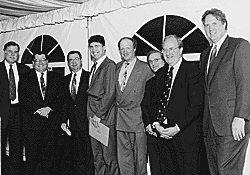| Osgood/Thesis
Day | Robert
Bailey Osgood Lecture | Senior Residents Thesis Presentations Back to HOJ HOME |
| Senior Resident Thesis Presentations | |
 |
First
Session Moderated by Harry E. Rubash, MD |
| Harry Rubash |
First Session | Second Session | Third Session | Fourth Session | Awards |
|
|
The Functional Outcome of Operative Treatment of Ununited Fractures of the Humeral Diaphysis in Elderly Patients. David Ring, MD Focusing on the distinct population of elderly patients with painful, unstable nonunions of the humeral shaft, Dr. David Ring presented the surgical outcomes of 22 consecutive patients treated with open reduction and internal fixation and autogenous bone grafting. Using the Enforced Social Dependency Scale and the Disabilities of the Arm, Shoulder, and Hand outcomes instruments as measures of functional outcome, he demonstrated dramatic improvements in function following operative treatment. While fixation of osteoporotic bone can present a formidable challenge, the data in this series demonstrated that when specific techniques intended for the fixation of osteoporotic bone are used (including long plates, blade plates, and enhancements of screw fixation such as Schuhli washers, 6.5 millimeter cancellous screws, or cement) a high rate of union (91%) with no failure of fixation is attainable. Dr. Gregory Altman emphasized that this study applies to a subset of humeral nonunions in elderly patients that are severely disabling - nonunions that are mobile, unstable, and painful - and that patients with stable nonunions occasionally function well with a supportive brace alone. Dr. Buckwalter agreed that this study was a good example of the usefulness of outcomes instruments, but lamented the fact that population norms do not, as of yet, exist for the instruments used. |
|
| David Ring | ||
 |
||
| Gregory Altman |
|
|
Current State of Orthopaedic Education: The Role of Multimedia Jeffrey Guy, MD Dr. Jeffrey Guy chronicled the development of the new internet home page for the Harvard Combined Orthopaedic Surgery Residency Program. During his real-time demonstration of the resources and capabilities already available on the 'Harvard Orthoweb,' Dr. Guy described the potential role of multimedia and internet technology in promoting resident education and furthering uniting Harvard-affiliated hospitals and institutions. A major part of his project will be the development of an intranet of educational resources and databases available to Harvard Staff and Residents. Dr. Mark Koris praised Dr. Guy's work and promoted the idea of using electronic media to develop educational resources. |
| Jeff Guy | |
 |
|
| Mark Koris |
|
|
Bone Mineral Density is Reduced in Vertebrae Instrumented for Adolescent Idiopathic Scoliosis Hieu Ball, MD Dr. Hieu Ball used a proprietary computer algorithm for calculating bone mineral density of the spine using DEXA in the presence of internal fixation devices. In a short-term, prospective study of 8 patients with average of two-year follow-up and a long-term retrospective analysis of 15 patients with 17-year average follow-up, he demonstrated significant decreases in bone mineral density of vertebral bodies when the posterior elements had been fused. Density was not decreased in vertebrae adjacent to the fused area. Dr. Timothy Hresko was enthusiastic about the computer algorithms that make it possible to measure bone density adjacent to internal fixation device, but questioned the clinical importance of decreased bone density anteriorly when the posterior structures have been fused. |
| Hieu Ball | |
 |
|
| M. Timothy Hresko |
Osgood/Thesis Day | Robert Bailey Osgood Lecture
NEXT PAGE | TOP OF PAGE | HOJ HOME





















